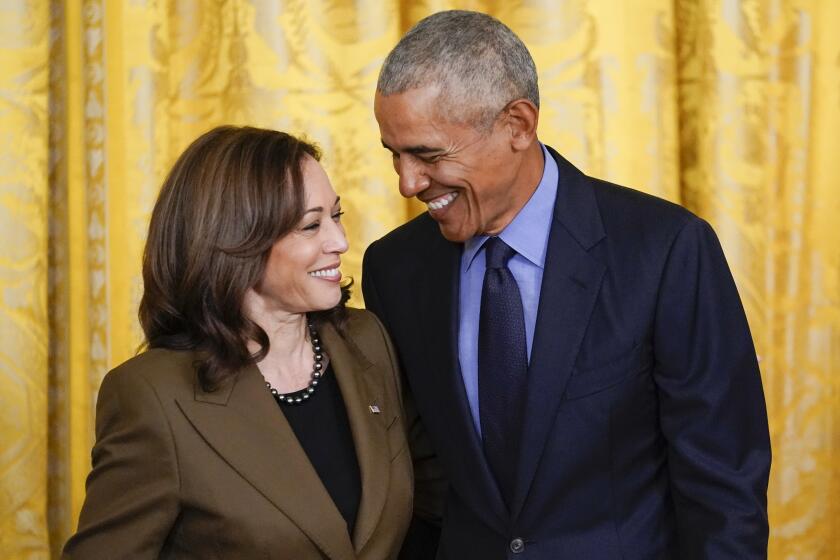Showdown Nears on Housing Legislation : Financing: Bills in Senate and House would help buyers and renters. But more costly House measure faces Bush veto.
A showdown is set on the most far-reaching housing bill proposed in a decade when Congress returns from its summer recess next month.
The House set the stage when it approved a $28-billion bill that would start a variety of programs to help first-time buyers, make it easier for government-subsidized renters to purchase their apartments and encourage production of new rental housing.
The House bill--approved by a 378-43 vote before members adjourned earlier this month--would also make the loan program run by the Federal Housing Administration available to more borrowers while, at the same time, attempt to shore up the agencyâs shaky finances.
But the House bill is far different and much more expensive than a $17.8-billion package that the Senate has approved and which the Bush Administration supports.
A joint House-Senate conference committee will try to reach a compromise when Congress returns after Labor Day.
If a compromise canât be reached, thereâs a chance that lawmakers will have to start all over again next year--ending a three-year effort to pass the far-reaching legislation.
Even if the committee is successful in reaching a deal thatâs palatable to both sides, Bush says heâll veto the compromise if it contains key elements currently in the House bill--including more spending for the construction of low-income housing and controversial changes to the popular FHA loan program.
Such a veto would be difficult to override, once again forcing lawmakers to start from scratch when an all-new Congress convenes after the November elections.
âIâm not sure that sparks will fly, but Iâd say that the conference session will be long and arduous,â said John Blount, a top lobbyist for the National Assn. of Realtors.
The realtors--along with the National Assn. of Home Builders, several lenders trade groups and a handful of consumer groups--back the House bill.
But Bush and Jack Kemp, chief of the U.S. Department of Housing and Development, favor the less-costly legislation that has been approved by the Senate.
The Senate bill, dubbed âthe National Affordable Housing Act,â was authored by U.S. Sens. Alan Cranston (D-Calif.) and Alfonse DâAmato (R-N.Y.). The companion bill is sponsored by Rep. Henry B. Gonzalez, chairman of the powerful House Banking, Finance and Urban Affairs Committee.
There are two main differences between the proposal that has been passed by the Senate and the bill that has been approved by the House.
First, the House bill would have the federal government spend billions of dollars to encourage new construction and renovation of low-income rental units. The Senate proposal wouldnât spend nearly as much on low-income housing.
But perhaps the most important difference between the two bills concern changes to the Federal Housing Administrationâs popular loan program, which is overseen by HUD.
The Senate proposal, backed by Bush and Kemp, would require borrowers who use the FHA loan program to continue paying a mortgage-insurance premium equal to 3.8% of their total loan amount.
However, borrowers who make less than a 10% down payment would also have to pay an additional one-half of 1% ârisk premiumâ on top of the 3.8% currently required.
The surcharge would add about $40 to the monthly payment on a $100,000 loan at 10%, according to the realtors.
Finally, the Kemp-backed Senate proposal would also require that borrowers pay two-thirds of their closing costs in cash, raising the amount of up-front money needed to get a $100,000 loan by about $1,266.
The changes are needed, Kemp said, to make the FHA âactuarially sound.â
Although the primary FHA fund had a net worth of $2.6 billion at the end of the latest fiscal year, Kemp has said it will have âa negative net worth unless something is doneâ to stem its growing number of foreclosure losses.
HUD analysts estimate that 35,000 Americans will immediately be knocked out of the housing market if the Kemp plan is approved.
Realtors, builders and others who oppose the plan say that number would be much higher--perhaps as high as 250,000 people a year.
âThe proposal supported by the Administration would turn the FHA program on its head,â said Rep. Bruce F. Vento (D-Minn.), who played a key role in drafting the House plan.
âWe are debating not only the future of the FHA program but of many young families who would like to purchase a home.â
Although the House plan is more complex, Vento and his supporters say it will give the FHA the financial boost it needs while, at the same time, be much easier on the nationâs would-be home buyers.
The House proposal would essentially phase out over five years the 3.8% up-front insurance premium that borrowers must pay and instead require that a payment equal to 1.35% of the loan amount be paid when the loan closes.
Borrowers would also pay an annual ârenewal feeâ equal to .6% of the original loan amount.
âIn short, the House plan would keep the FHA program open to people who have only small down payments and transform it into a true âpay-as-you-goâ system,â said Michelle Meier, an executive and lobbyist with the nonprofit Consumers Union.
Meierâs organization, which has successfully lobbied in the past for regulatory changes that have benefited borrowers, has joined realtors and builders in support of the House bill.
Realtor officials plan to meet with Kemp on Tuesday in an effort to persuade him that the House proposal would âensure the FHAâs future viability but also keep it open to the people who need it most,â lobbyist Blount said.
âThe President listens to Mr. Kemp,â Blount said. âIf we can convince Mr. Kemp that the Houseâs proposal is better, we hope to avoid a veto.â
Exactly how Kemp responds to the realtorsâ arguments will play a key role in what happens to the two bills next.
If Kemp and Bush drop their opposition to the Houseâs plans for the FHA, the House-Senate conference committee will likely have an easier time passing a compromise measure that Bush can sign into law.
But if Kemp and Bush canât be swayed, conferees from the Senate and House are probably in for some contentious debates.
If a compromise is reached but Bush vetoes it, the veto could be hard to override. The President has killed 13 measures during his tenure and hasnât had a single one overturned.
Compounding the problem, Congress is set to adjourn for the year Oct. 5. Even if lawmakers can hammer out a compromise before then, they might not have time to attempt a veto override.
Bush could also utilize a âpocket vetoâ by simply refusing to sign a compromise measure. If he does, Congress would be denied the chance of even attempting to override the President.
The current Congress has struggled for nearly three years to formulate the two bills that the conference committee will take up next month. But all 435 members of the House are up for reelection this year, and so is one-third of the Senate.
If a compromise isnât passed and signed into law by Bush, a new Congress will have to start from scratch when it convenes in January.
âThree years of blood, sweat and tears are riding on Congress and the Administration,â lobbyist Blount said.
âI canât predict how itâll all turn out, but Iâll tell you this: The next month or two will be crucial to the future of Americaâs housing market.â
HOUSING BILL HIGHLIGHTS
Both the House and the Senate agree that first-time buyers and low-income renters need help to beat the fast-rising cost of housing. Here are some of the highlights of the two housing bills that are scheduled to go to a joint conference committee next month:
* Establishment of a ânational housing trust fund.â The new fund would help first-time buyers by subsidizing their down payment and closing costs. Mortgage rates will also be subsidized: Borrowers would pay no more than 6%. Subsidies would be repaid when the home is sold.
* Rental housing production. Authorize low-interest repayable advances to nonprofit groups, private developers and public housing agencies for up to 50% of the cost to build, buy or renovate âaffordableâ rental housing. A portion of the units would have to be set aside for the poor.
* Community housing partnership. Grants and loans would be made to states, municipalities and nonprofit groups to maintain, rehab, buy or build homes. The homes would then be rented or sold to low- and moderate-income people. Project sponsors would put up $1 for every $3 provided by the program.
* Public and Indian home ownership. HUD would hold national competitions to help public housing tenants buy their homes. Grants would be made to develop resident management corporations and home ownership plans.
* Multifamily and single-family home ownership. Would enable groups to buy and fix up property currently owned and operated by federal, state and local governments. Properties would then be sold to low-income families.
* Vacant public housing. HUD would provide grants to public housing authorities to rehab or raze vacant public housing developments.
* Family self-sufficiency. A new program would be established to coordinate various public-housing programs and subsidies to help families get off public assistance.
SOURCE: Congressional Quarterly
AVERAGE RATES FOR RESIDENTIAL MORTGAGES Average rates for residential mortgages as of Aug. 10, 1990.
Conventional Mortgages
Survey Area 15 Year 30 Year Composite National 9.84% 10.17% 10.02% California 10.10 10.41 10.26 Connecticut 9.93 10.22 10.10 Wash. D.C. 9.66 10.05 9.88 Florida 9.80 10.14 9.98 Mass. 9.95 10.31 10.15 New Jersey 9.83 10.14 10.00 N.Y. Metro 9.92 10.23 10.10 New York 10.02 10.33 10.20 N.Y. Co-ops 10.30 10.55 10.46 Pa. 9.65 9.96 9.82 Texas 9.61 10.02 9.84
Adjustable Mortgages
Survey Area 1 Year Composite National 8.21% 8.50% California 8.56 8.42 Connecticut 8.27 8.49 Wash. D.C. 7.86 8.21 Florida 8.22 8.35 Mass. 8.31 8.58 New Jersey 8.10 8.53 N.Y. Metro 8.26 8.60 New York 8.39 8.69 N.Y. Co-ops 8.56 8.88 Pa. 7.93 8.06 Texas 8.23 8.39
SOURCE: HSH Associates, Butler, N.J.
More to Read
Get the L.A. Times Politics newsletter
Deeply reported insights into legislation, politics and policy from Sacramento, Washington and beyond. In your inbox three times per week.
You may occasionally receive promotional content from the Los Angeles Times.










